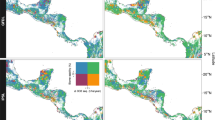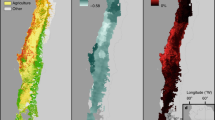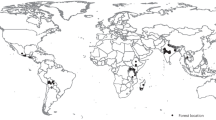Abstract
Climate change and biodiversity loss can be addressed simultaneously by well-planned conservation policies, but this requires information on the alignment of co-benefits under different management actions1,2,3. One option is to allow forests to naturally regenerate on marginal agricultural land: a key question is whether this approach will deliver environmental co-benefits in an economically viable manner4,5,6,7. Here we report on a survey of carbon stocks, biodiversity and economic values from one of the world’s most endemic-rich and threatened ecosystems: the western Andes of Colombia. We show that naturally regenerating secondary forests accumulate significant carbon stocks within 30 years, and support biodiverse communities including many species at risk of extinction. Cattle farming, the principal land use in the region, provides minimal economic returns to local communities, making forest regeneration a viable option despite weak global carbon markets. Efforts to promote natural forest regeneration in the tropical Andes could therefore provide globally significant carbon and biodiversity co-benefits at minimal cost.
This is a preview of subscription content, access via your institution
Access options
Subscribe to this journal
Receive 12 print issues and online access
$209.00 per year
only $17.42 per issue
Buy this article
- Purchase on Springer Link
- Instant access to full article PDF
Prices may be subject to local taxes which are calculated during checkout


Similar content being viewed by others
References
Venter, O. et al. Harnessing carbon payments to protect biodiversity. Science 326, 1368–1368 (2009).
Miles, L. & Kapos, V. Reducing greenhouse gas emissions from deforestation and forest degradation: Global land-use implications. Science 320, 1454–1455 (2008).
Busch, J., Godoy, F., Turner, W. R. & Harvey, C. A. Biodiversity co-benefits of reducing emissions from deforestation under alternative reference levels and levels of finance. Conserv. Lett. 4, 101–115 (2011).
Phelps, J., Friess, D. A. & Webb, E. J. Win-win REDD+ approaches belie carbon-biodiversity trade-offs. Biol. Conserv. 154, 53–60 (2012).
Edwards, D. P., Fisher, B. & Boyd, E. Protecting degraded rainforests: Enhancement of forest carbon stocks under REDD+. Conserv. Lett. 3, 313–316 (2010).
Alexander, S. et al. Opportunities and challenges for ecological restoration within REDD+. Restor. Ecol. 19, 683–689 (2011).
Phelps, J., Webb, E. L. & Adams, W. M. Biodiversity co-benefits of policies to reduce forest-carbon emissions. Nature Clim. Change 2, 497–503 (2012).
Larsen, F. W., LondoñoMurcia, M. C. & Turner, W. R. Global priorities for conservation of threatened species, carbon storage, and freshwater services: Scope for synergy? Conserv. Lett. 4, 355–363 (2011).
Siikamäki, J. & Newbold, S. C. Potential biodiversity benefits from international programs to reduce carbon emissions from deforestation. Ambio 41, 78–89 (2012).
Lamoreux, J. F. et al. Global tests of biodiversity concordance and the importance of endemism. Nature 440, 212–214 (2005).
Orme, C. D. L. et al. Global hotspots of species richness are not congruent with endemism or threat. Nature 436, 1016–1019 (2005).
Myers, N., Mittermeier, R. A., Mittermeier, C. G., Da Fonseca, G. A. & Kent, J. Biodiversity hotspots for conservation priorities. Nature 403, 853–858 (2000).
Brooks, T. M. et al. Habitat loss and extinction in the hotspots of biodiversity. Conserv. Biol. 16, 909–923 (2002).
Armenteras, D., Gast, F. & Villareal, H. Andean forest fragmentation and the representativeness of protected natural areas in the eastern Andes. Biol. Conserv. 113, 245–256 (2003).
Sánchez-Cuervo, A. M., Aide, T. M., Clark, M. L. & Etter, A. Land cover change in Colombia: Surprising forest recovery trends between 2001 and 2010. PLoS ONE 7, e43943 (2012).
Olschewski, R. & Benitez, P. C. Secondary forests as temporary carbon sinks? The economic impact of accounting methods on reforestation projects in the tropics. Ecol. Econom. 55, 380–394 (2005).
Peters-Stanley, M., Gonzalez, G. & Yin, D. Covering New Ground: The State of Forest Carbon Markets 2013 (Ecosystem Marketplace and Forest Trends, 2014).
Pulliam, R. & Danielson, B. J. Sources sinks and habitat selection: A landscape perspective on population dynamics. Am. Nat. 137, 50–66 (1991).
Chazdon, R. L. Beyond deforestation: Restoring forests and ecosystem services on degraded lands. Science 320, 1458–1460 (2008).
Turner, I. M. & Corlett, R. The conservation value of small isolated fragments of lowland tropical rain forest. Trends Ecol. Evol. 11, 330–333 (1996).
Raboin, M. L. & Posner, J. L. Pine or pasture? Estimated costs and benefits of land use change in the Peruvian Andes. Mountain Res. Dev. 32, 158–168 (2012).
Fisher, B. et al. Implementation and opportunity costs of reducing deforestation and forest degradation in Tanzania. Nature Clim. Change 1, 161–163 (2011).
Schwarze, R., Niles, J. O. & Olander, J. Understanding and managing leakage in forest-based greenhouse-gas-mitigation projects. Phil. Trans. Math. Phys. Eng. Sci. 360, 1685–1703 (2002).
Davis, K. et al. Impact of farmer field schools on agricultural productivity and poverty in East Africa. World Devel. 40, 402–413 (2012).
Kanowski, P. J., McDermott, C. L. & Cashore, B. W. Implementing REDD+: Lessons from analysis of forest governance. Envir. Sci. Policy 14, 111–117 (2011).
Barr, C. M. & Sayer, J. A. The political economy of reforestation and forest restoration in Asia–Pacific: Critical issues for REDD+. Biol. Conserv. 154, 9–19 (2012).
Sierra, C. A. et al. Total carbon stocks in a tropical forest landscape of the Porce region Colombia. For. Ecol. Manage. 243, 299–309 (2007).
Chao, A. R. L., Chazdon, R. K., Colwell, R. & Shen, T-J. A new statistical approach for assessing compositional similarity based on incidence and abundance data. Ecol. Lett. 8, 148–159 (2005).
Anderson, M. J. & Willis, T. J. Canonical analysis of principal coordinates: A useful method of constrained ordination for ecology. Ecology 84, 511–524 (2003).
Dorazio, R. M., Royle, J. A., Soderstrom, B. & Glimskar, A. Estimating species richness and accumulation by modeling species occurrence and detectability. Ecology 87, 842–854 (2006).
Acknowledgements
We thank F. Forero, J. S. Cardenas, A. Gonzalez and other staff at the Instituto de Investigación de Recursos Biológicos Alexander von Humboldt for field support, and Fundación Colibri, Fundación ProAves and L. Tapasco for access permissions. We thank Y. Tapasco, O. Cortes, F. Prada, G. Suarez and many local guides for fieldwork. Funding was provided to T. Haugaasen and D. Edwards by the Research Council of Norway, grant number 208836. Specimens were deposited at the Instituto Alexander von Humboldt Collections, Colombia (Permit Number 1579). This is publication #2 of the Biodiversity, Agriculture and Conservation in Colombia (BACC) project.
Author information
Authors and Affiliations
Contributions
D.P.E., T.H. and J.J.G. conceived the study. D.P.E., J.J.G., F.A.E., P.W., C.W. and C.A.M.U. collected data. J.J.G. analysed the data and wrote the first draft. All authors contributed substantially to revisions.
Corresponding authors
Ethics declarations
Competing interests
The authors declare no competing financial interests.
Supplementary information
Rights and permissions
About this article
Cite this article
Gilroy, J., Woodcock, P., Edwards, F. et al. Cheap carbon and biodiversity co-benefits from forest regeneration in a hotspot of endemism. Nature Clim Change 4, 503–507 (2014). https://doi.org/10.1038/nclimate2200
Received:
Accepted:
Published:
Issue Date:
DOI: https://doi.org/10.1038/nclimate2200
This article is cited by
-
Carbonservation with Demonstrated Biodiversity and Carbon Gains: Carbon Can Pay But Biodiversity Must Lead
Environmental Management (2024)
-
Assessing carbon sequestration in a high-diversity restoration plantation in the Atlantic Forest of southwestern Brazil
Regional Environmental Change (2023)
-
Landscape management strategies for multifunctionality and social equity
Nature Sustainability (2023)
-
Implications of zero-deforestation palm oil for tropical grassy and dry forest biodiversity
Nature Ecology & Evolution (2022)
-
Relocating croplands could drastically reduce the environmental impacts of global food production
Communications Earth & Environment (2022)



